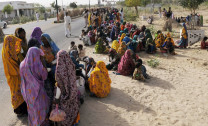Karachi, Quetta receive scattered rain
Showers further lower temperature in provincial capitals

A representational image of rain. PHOTO: AFP
There were reports of snowfall in Swat, as moist is eagerly awaited in the plains of Punjab where dense fog has made visibility poor and affected daily life.
The Pakistan Meteorological Department (PMD) said that the current westerly wave will bring showers and scattered rains in upper parts of the country in the next 24-48 hours.
It forecast rain and snowfall in upper and central parts of the country from Sunday till Tuesday.
According to the weather advisory issued by PMD, a westerly wave is affecting western and upper parts and is likely to affect central parts of the country.
According to PMD, rain with thunderstorm is expected at scattered places in Quetta, Zhob, Malakand, Hazara, Mardan, Peshawar, Kohat, Rawalpindi, Gujranwala, Lahore, Faisalabad, Sargodha, DG Khan divisions, Islamabad, Gilgit-Baltistan and Kashmir, Bannu, DI Khan, Multan, Sahiwal, Bahawalpur and Karachi divisions.
Snowfall is also predicted in Swat, Chitral, Kalam, Malam Jabba, upper Dir, Hazara division, Murree, Galliyat, Kashmir and Gilgit-Baltistan.
Meanwhile, the ‘Asia-Pacific Impact Outlook’ for December 2018 to February 2019 issued by the UN Economic and Social Commission for Asia and the Pacific (UNESCAP) has said that considering the warm ocean conditions prevailing in the Pacific, there is consensus that weak El Nino conditions are likely to develop and continue through the winter season.
The outlook forecast that above-normal rainfall is likely during the winter season till February 2019 over some areas of northern parts of Pakistan, Afghanistan, India and some areas of north Myanmar. Normal to above-normal temperature is likely to prevail over most parts of the region.
The forecast recommended that countries that are at risk from significant climate deviations during the next few months should assess local risk due to El Nino and other factors. Local assessment is important because the El Nino can affect locations and sectors differently. The prevailing climate and socio-economic conditions, which can also vary dramatically across locations, could either lessen or amplify the impacts, it says.
(With additional input from APP)



















COMMENTS
Comments are moderated and generally will be posted if they are on-topic and not abusive.
For more information, please see our Comments FAQ